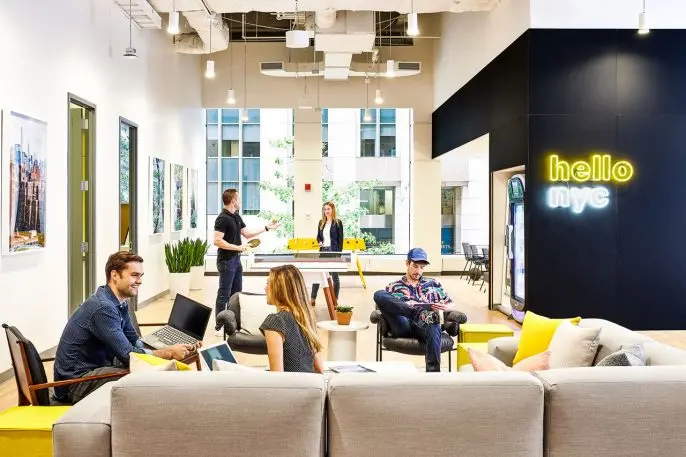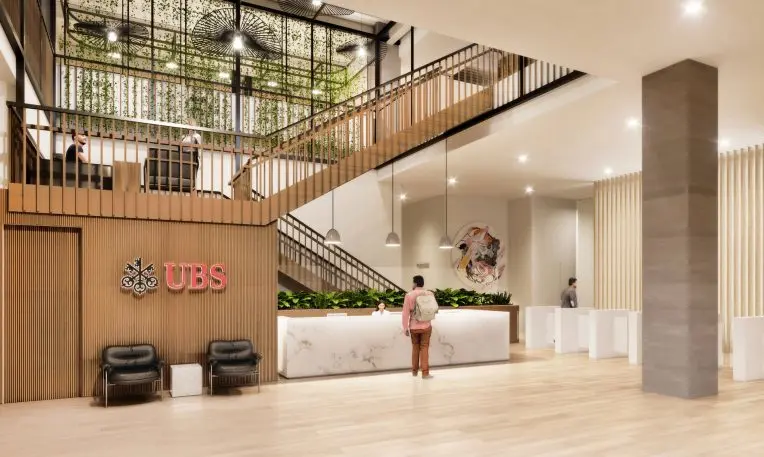A year ago, just a few months after joining WeWork as head of enterprise business, Veresh Sita strode onto a stage at Madison Square Garden during the company’s annual global summit to announce a whole new direction for the company. Blue and red lights beamed around the cavernous arena as Sita addressed 4,000 of his raucous new colleagues.
“You heard earlier speakers talk about this as our equivalent of AWS,” he said, referring to Amazon Web Services, the online retailer’s massively lucrative cloud business. “We have built these amazing workplaces and we’re now able to take these workplaces into enterprises.”
He was talking about a newly launched product called Powered By We, a design, renovation, and office management service. Powered by We was a big expansion from the company’s previous business, which required customers to take space—a desk, a personalized office—inside of a WeWork leased property. Now, WeWork could come to you. What’s more, Sita said, through another new initiative called Global Access, clients could use any site in the WeWork network, whenever they wanted. It gave traveling employees the ability to set up shop somewhere better than a coffee shop or hotel, even on short day trips. “Think of it as a WeWork black badge,” he said.
This was the beginning of WeWork’s push into a wider variety of services for business and beyond shared workspace—which is essentially just a rent arbitrage business. More importantly it was the next step toward better capitalizing on its most prized asset—its community.
“When we talk with enterprise companies,” Sita said, “we tell them that we are building the largest physical social network in the world.”
WeWork has amassed a $47 billion valuation on the premise that sharing real estate resources will make living and working more efficient and affordable (and fun!) for everyone. Data and analytics, the company professes, will help WeWork cut costs in a way that landlords can’t or haven’t yet. Over the last couple of years, with the help of massive funding from SoftBank, WeWork has stockpiled much of the tools it needs to make good on that promise. It now has a worldwide network of 425 buildings, a small percentage of which it partially owns, and a team of architects, designers, construction experts, community managers, and technologists who can now service Fortune 500 companies on their own turf. Which is to say, WeWork is shifting its business away from rent arbitrage to a higher-margin services business. However, much of its community was built on the back of rent arbitrage, and it still has huge portfolio of leases. If market experts are to be believed, we’re heading for a downturn and, historically, rent arbitrage businesses don’t fare so well under those circumstances. The company is also still growing and spending lots of money on expansion. So, as WeWork surpasses $1 billion in annual losses, many are wondering how much this is all worth.
The Amazon of work?
WeWork has big ambitions to be the one company you need to source all of your real estate needs: a place to co-live, a place to work, a place to work out, a place to learn, a place to grow. From the outset, WeWork intended to offer a variety of accommodations (WeSail) and even financial services (WeBank). Though these verticals aren’t currently being pursued, they reveal a vast vision.
In an effort to clarify that it’s not just a coworking company, but a platform for all aspects of your modern life, WeWork created “The We Company” as an umbrella for its three main verticals—WeLive, WeWork, WeGrow. WeWork remains the most important. It’s the segment that drives all of the company’s current revenue and could fund the rest of its highly ambitious plans.
Where Amazon perfected the everything store, complete with searchable review-laden products, WeWork wants to be the everywhere store, a brand that has a place for everything you need to do. Also like Amazon in its early days, WeWork is losing lots of money. In the first three quarters of 2018, it took down $1.2 billion in losses.

Most recently, it’s put that money to work building out a network that allows members to scale up services as they grow or downsize when they fall on hard times. One where a business’s employees can be redistributed across both a company’s own offices and WeWork properties. WeWork promises to handle all aspects of office life—sourcing the space, renovating it, maintaining it, creating events for it—leaving little incentive for companies that join WeWork to ever leave.
That’s the big idea, anyway. Where Amazon’s cloud computing platform serves as a digital home for businesses, WeWork wants to be the real estate equivalent. And just as AWS serves as a huge profit center for Amazon, the We Company’s office-space-as-a-service business could be the same.
The most substantial criticism against WeWork is that it’s overvalued for a company that only earns revenue on rent arbitrage. By contrast, IWG International, a coworking company with 3,300 locations and 2.5 million members globally, has a market capitalization of $2.1 billion. Of course, back in 2003, when IWG was Regus, it was forced to file for bankruptcy after the dotcom bubble burst and it couldn’t renegotiate lease terms with its landlords.
Expanding into consultation, architecture, construction, and office management allows WeWork to court more lucrative and complex deals, and longer leases. “WeWork’s enterprise business is vital to its long-term strategy, ” notes CB Insights in its 2019 WeWork Teardown Sheet. “If the company continues to add co-management deals that cater to large corporates, it has a strong shot at living up to its sky-high valuation,” the report says, but if these relationships prove superficial then WeWork might be in trouble.
In a 2018 report, CB Insights noted that some environmental factors were shifting in WeWork’s favor. A relatively new U.S. rule requires companies to report real estate leases as a liability and as such, “corporations across the globe are searching for ways to lower their total square footage to cut costs,” according to the report.
Commercial remodeling spend reached $1.5 trillion in 2017, according to Global Market Insights. It’s expected to hit $2.2 trillion by 2024. While the industry continues to grow, the nature of remodeling is changing. As more office arrangements come on the market, companies are increasingly demanding workspaces that bend and flex with their needs, according to CBRE’s 2019 Global Real Estate Market Outlook. Many companies are also catching up to the idea that a well designed space and carefully curated culture can attract and keep top talent.
Since January 2018, WeWork has signed deals for 220 custom offices from a bank of 2,000 enterprise-level clients, each of which employs more than 1,000 workers. As of September 2018, it had generated $1.1 billion in revenue for leases and services. The company as a whole expected to hit a run-rate of $2.3 billion in December. But The We Company is still very much investing in growth and losing more than it’s taking in.
The evolution toward tech
Before WeWork took a scalpel to Sprint’s office in midtown, the space looked like many others in New York: a small front reception area that hides a maze of grey, high-walled cubicles behind it. “We left this floor and we came back couple of months later. Done,” says Sprint’s Northeast business president, Claudio Hidalgo, swiping his hands like an umpire calling a runner safe on base.
Hidalgo, who talks fast and punctuates monologues with an open-mouth smile, says you could never tell if anyone was in the office, because you couldn’t see them. Standing in the office’s new front lounge, he points to a row of booth seats, each filled with a cluster of employees, as an example of how the redesign has made the space more open. The majority of workers in this office are sales representatives that spend much of their time outside the office wooing clients, he explained. Retail staff also come in regularly for training here.
The new office feels like, well, a very modern Sprint retail store. The walls are a pristine white. Employees are draped over black, gray, and yellow plush chairs and sofas in a big open lounge. Drake gently whines over the sound system, “I’ve been down so long, it look like up to me. They look up to me.” The only hint of WeWork is the man in a black tee attending to a glass water dispenser on a long white countertop in an open kitchen.
Though parts of the office are open, the work spaces are separated by need. There’s one for sales representatives and a quieter, more-tucked-back area for the IT department. WeWork got rid of individual offices and put in a wellness room, a room for breastfeeding mothers, two training rooms, a string of phone booths, and nine conference rooms. The office’s technological infrastructure also got an upgrade, including new displays and videoconferencing systems. Hidalgo says the partnership with WeWork led to other advancements as well.

This is just a sliver of the innovation Sita has been driving toward since WeWork hired him 17 months ago. Back in December 2017, before his big Summit debut, he laid out the big vision to me. In a perfect WeWork world, he said, your office will recognize who you are when you arrive, adjust your desk height, dim the lights like you like, and put in an order at the cafe in your office for a latte, skim milk, no foam. It does this because you previously plugged all this information into an app. When you schedule a conference room that’s bigger than you need (it was the only one available), the office management system rearranges the bookings so that each meeting is matched with an appropriately sized room. Sita also talked about exploring a way to gather passive data through beacons or perhaps cameras that could determine employee sentiment.
“I believe that users will give up a degree of anonymity when giving them a level of service in return,” he said at the time.
A year later, WeWork is in the process of building the tech stack that Sita described. For its custom designs, WeWork sets up beacons and other sensors around the office to visualize how employees move about the office. It also conducts employee surveys and interviews and uses all these insights to develop a plan for the office. One way WeWork plans to continue its relationship with clients long after the newly plastered walls have dried up, is by keeping these sensors in place and using that data to tweak designs over time based on feedback, much like an engineer iterates software. But this feature isn’t solely reliant on technology. In some of its client offices, WeWork can also turn to its community members for observations.
When it comes to running the office, WeWork, for now, offers its custom clients the same technology it uses in its coworking offices. It does the basics: scans members into buildings, books conference rooms, networks Wi-Fi, connects computers to printers, and coordinates tech support. But to achieve its grand vision, it needs to do more.
“A lot of our tech stack is really built to run WeWork,” says Fano, “Being able to copy-paste that into enterprise environments is nontrivial.” It’s not only complicated transplanting the software WeWork built for its coworking offices into other people’s spaces, it may not even make sense. An individual company may want a system that is more neutral and can connect to the rest of their tech ecosystem. That’s why the company is in the process of building out a separate conference-room booking and office-management platform that can integrate with myriad office software and be customized for individual clients.
In July, WeWork hired Kendall Collins, formerly CMO at AppDynamics, to head up the technology development. Two months later, the company announced its intention to buy Teem, a platform that manages conference rooms and creates little heat maps of employees as they move about the office. Most importantly, Teem integrates with Microsoft Office, Google for Work, Dropbox, Slack, and other common office software, which WeWork needs in order to automate and manage office flow (like the magic conference-room booking efficiencies Sita spoke about earlier).
While WeWork builds out its client-facing office software, it’s also been working on a suite of internal apps and technologies to automate much of its own work. In 2015, it acquired Case, a consultancy that uses 3D building scans to estimate costs and timeframes for design and construction. Two years later it bought FieldLens, a mobile-based construction management tool. WeWork is using data science to make determinations about what product and spaces to recommend to clients and at what price point. It’s also using analytics to help determine when a company is outgrowing its existing WeWork-run space and ready to level-up (or if there are opportunities to pare down).
While WeWork says technology is what separates it from other real estate companies, there are quite a few companies in the industry who investing in tech.
Architecture firms have been working on similar technology for years. In 2015, Deloitte opened The Edge, a PLP Architecture designed tech-enabled green building that tracks how the office is used. Steelcase, the furniture company, in collaboration with Microsoft Azure, released an app and platform for better understanding office use in 2017. Architecture firm Gensler also uses similar technology to collect information about a space and its inhabitants before its architects begin the design process. Technology companies too are making their software available to better understand how the office is impacting productivity. This year, analytics company Sisense and data collector Measuremen announced a partnership to analyze use and efficiency for European e-commerce company Bol.com’s new office in Amsterdam.
Amanda Carroll, Principal and Workplace Leader at Gensler, says that being able to customize your individual office experience is going to become as regular as organizing apps on your phone. We spoke while she was attending the Institute of Real Estate Management’s October global summit in Toronto. The expectation, she says, is that in the future an office platform or a building network will be able to swipe you in through the front turnstiles and whisk you up to the right floor based on your schedule. “That is the kind of automation people will value and opt in for,” she says.
There are questions about how much data companies will ultimately want to give up to WeWork or any real estate company. At the moment, relatively few companies engage with these kind of advanced office analytics. Gensler director of analytics Wes LeBlanc estimates that fewer than 5% of the company’s clients are using sensors currently, though he says conversations about office data constitute a third to half of the conversations the firm is having with current clients.
While technology powers the efficiencies WeWork can offer clients, some companies seem more interested in its ability to manage traditional commercial real estate logistics. Marc Montanaro, head of human resources for UBS America’s region, says the advantage to working with WeWork is that it handles all aspects of the renovation.

UBS has a 4,400-person office in Weehawken, New Jersey that hasn’t been updated since the late 1980s. “Speaking openly,” says Montanaro, “today, people really don’t want to go there for meetings, because it’s stale.”

The first phase of the New Jersey office is expected to be finished by spring, with the total 108,000-square-foot renovation wrapping late in 2020. It could have been faster, he says, but UBS decided to renovate floors one at a time rather than expediting the construction and moving its employees to a WeWork or elsewhere in the interim.
“WeWork is very integrated, data-driven, and they have a very customized approach to designing and building enterprise spaces, and that’s really something that we at UBS wanted as an outcome there—something that is fully integrated,” says Montanaro.
The We network
Though UBS decided not to use the greater WeWork network during its renovation process, it is keen to make use of the company’s 425-building global real estate portfolio in the future. As fixed office spaces fall out of vogue, big corporates are looking for ways to move their workforce around. Roughly 41% of businesses say they expect to have 50 or more employees working out of a coworking location in the next three years, according to a 2018 CBRE survey.
Diageo, the global liquor brand, has a variety of spaces through WeWork in New York, San Francisco, Montreal, and Lima, Peru. The most unique is the single conference room it rents inside of a WeWork in New York. The company uses the space to host events for each of its many brands. In September, Bulleit Bourbon furnished the room in deep brown leather couches and operated the space as an open mixology lab for bartenders wanting to learn more about whiskey cocktails. The following month, Ketel One painted the room white and green and set it up as a meditation room tethered to the launch of its lower-calorie Botanicals line. The space, which has been painted gray and strewn with white cushions, is open to WeWork members.
Companies are using a range of WeWork products to create flexible work arrangements for their workers across the globe. This year, Pinterest opened a private office in Seattle through WeWork in order to dip into the city’s engineering talent pool. Though the office is in one of WeWork’s buildings, it has a private entrance for Pinterest employees and the company’s red and white branding throughout the office.
Beyond opening offices in new locales, companies are also using WeWork to reassess space. WeWork has been advising Sprint on how what to do with its giant 17-building campus and headquarters in Kansas City, Missouri. After consulting with WeWork, Sprint decided to sell—it’s in discussions with a buyer now—and lease back a portion of the buildings. Though the company is still determining how much space it will ultimately need, it was clear the property was being underutilized (Sprint laid off 500 employees in March 2018). In the interim, WeWork is already renovating one of the building’s Sprint plans to use. It’s slated to open this summer. (Sprint is in many ways WeWork’s ideal client: a large player that WeWork can embed itself with and grow the relationship. The company is also owned by We’s biggest investor, SoftBank.)
Similarly, companies are using WeWork to redistribute workers. Microsoft decided to expand beyond its main New York headquarters and open up two private offices inside of WeWork for 300 sales representatives to work in between client meetings. It also added an office in Philadelphia. In an internal survey, 84% of the people working out of those additional workspaces said they felt more productive. Microsoft further distributed its staff across the WeWork network by opting into WeWork’s Global Access, an all-access pass for some of its employees to post up at any WeWork around the world.
This—the ability to open an office anywhere they like, relatively affordably, and efficiently—may prove a big fuzzy lure for companies. Not just because more companies are expected to move employees to coworking spaces, but because companies’ needs are less static that they used to be.
So what’s it all add up to?
In the shift to the We Company, Veresh Sita’s title has changed. Powered By We now encompasses any custom office, whether on WeWork’s lease or someone else’s. It has become too large to be headed by a single person and is now divvied up into three segments: consultation, real estate, and technology. Sita runs the consultancy service, which is a sort of first line of inquiry, wherein he sits down with a company and determines their needs before handing off a client to his colleagues in real estate services or technology. Technology is led by Collins. Craig Robinson, who previously served as CEO of Global Corporate Services at Newmark Knight Frank, heads up the real estate component, known as enterprise services. They all report to Fano. When I talked to Dave Fano after The We Company announced its new name, he was mulling over whether WeWork was really the AWS of the We Company.
“I could say it’s AWS in terms of… more broadly the Work business,” he says. “It’s infrastructure as a service and it’s elasticity to deal with peaks and troughs of demand—real estate doesn’t have that.”
The central concern has always been that WeWork cannot sustain on rent arbitrage alone during an economic downturn. With its expanded model, it might be able to. Even if its smaller companies go belly up and need to back out of their leases, says Fano, big corporations already in the WeWork ecosystem looking to downsize quickly could move into some of those empty spaces.
Of course, none of that really answers the question of what WeWork is actually worth.
Up until two years ago, when WeWork started putting attention toward growing its enterprise customer base, the majority of its contracts were month-to-month leases. Its average lease these days, across coworking and its custom offices, is now 21 months. The company says that as of the fourth quarter 2018, it had “committed revenue backlog” worth $2 billion thanks to a growing stack of multiyear leases; money that it is contracted for, but will collect in the future over time. Big companies, not startups, WeWork says, have become its biggest revenue driver. Is it enough to withstand a downturn? That answer is still to come.
Correction: A previous version of this article misspelled the name of Marc Montanaro.
Recognize your brand's excellence by applying to this year's Brands That Matters Awards before the early-rate deadline, May 3.
